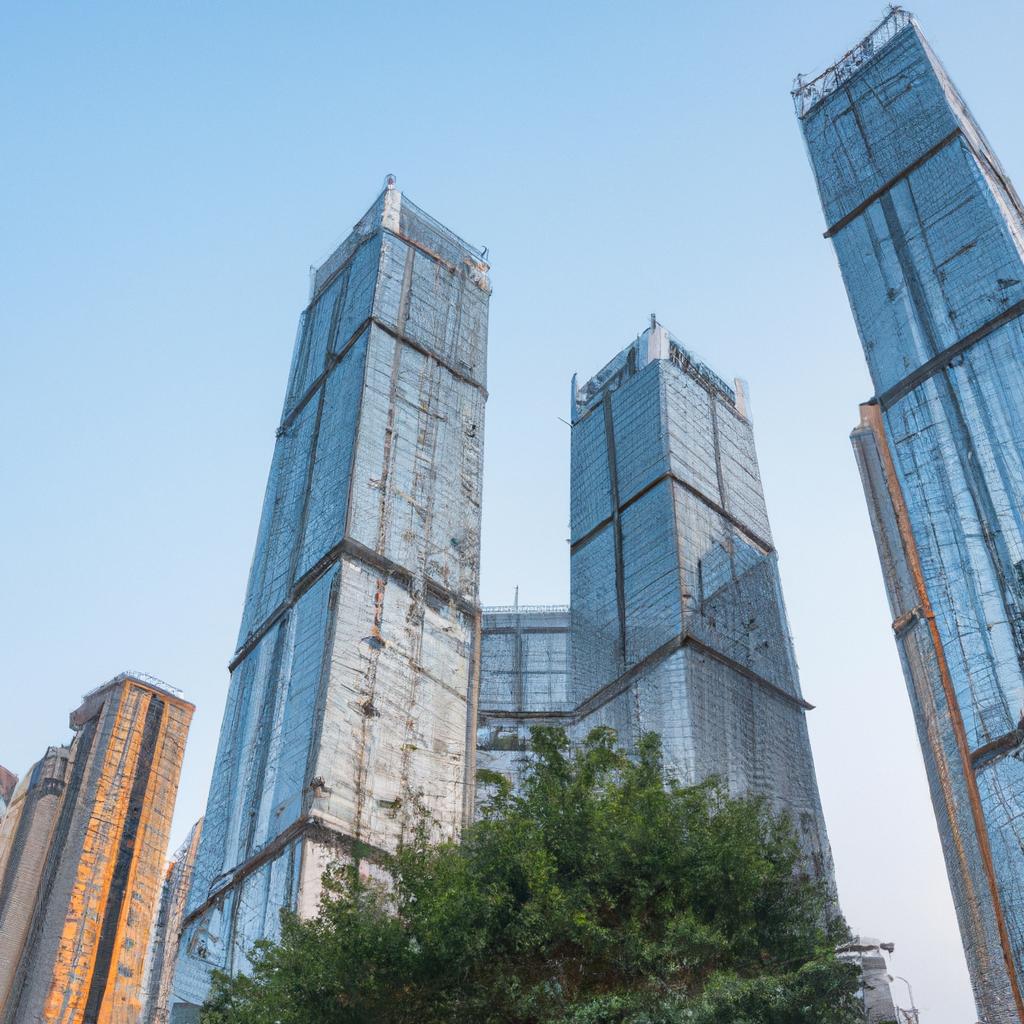Chongqing, a city situated in southwestern China, is famous for more than just its rich cultural heritage and beautiful landscapes. It is also known for its unique and captivating architecture. From traditional homes and temples to towering skyscrapers, Chongqing’s buildings have captured the attention of architects and tourists from around the world. In this article, we will delve into the significance of Chongqing buildings and what sets them apart in the realm of architecture.
A Fusion of Styles Guided by History and Geography
Chongqing’s architecture is a blend of various styles, influenced by the city’s history and geography. Nestled on the banks of the Yangtze River and surrounded by hills and mountains, the city’s natural surroundings have played a significant role in shaping its buildings. Over the years, Chongqing has been home to different ethnic groups, including the Bai, Yi, and Tujia, whose influences are evident in the city’s cultural heritage.
The Harmonious Blend of Traditional and Modern Styles
One of the remarkable aspects of Chongqing’s architecture is its ability to seamlessly merge traditional and modern styles. Traditional buildings in Chongqing are often constructed using wood and brick, adorned with intricate carvings and vibrant paintings. On the other hand, the city’s modern architecture features sleek lines and minimalist designs, showcased in its towering skyscrapers. However, despite their stylistic differences, all Chongqing buildings share a common goal of blending harmoniously with the surrounding natural environment, creating a balance between man-made structures and nature.
A Showcase of Cultural Heritage and Resilience
The significance of Chongqing’s architecture lies in its ability to showcase China’s rich cultural heritage while adapting to modernity without forsaking tradition. Chongqing’s buildings are a testament to the city’s resilience and determination, having withstood countless wars and natural disasters. Today, they stand tall as symbols of China’s architectural prowess and cultural diversity.
Exploring Chongqing’s Architecture
Now, let’s explore the history, famous buildings, contemporary architecture, and the importance of Chongqing’s buildings in more detail.
Historical Background of Chongqing Buildings
Chongqing’s history has had a profound impact on its architecture. As the capital of China during the Second World War, the city endured heavy bombings by the Japanese, resulting in the destruction of many buildings. Despite these challenges, Chongqing managed to preserve much of its cultural heritage, including its unique architecture. The city’s traditional buildings are characterized by wooden and brick structures with sloping roofs and intricate carvings, designed to blend harmoniously with nature.
Different Architectural Styles in Chongqing Buildings
Chongqing’s architecture is a testament to its diverse cultural influences. Building styles in the city encompass Sichuanese, Bai, and Tujia influences. Sichuanese architecture features timber, stone, and brick structures adorned with intricate carvings and colorful paintings. Bai architecture stands out with its signature white walls, black tiles, and elaborate carvings and murals. Tujia architecture is known for its wooden structures with sloping roofs and intricate carvings, often featuring balconies for crop drying and lookout purposes. The blending of these various styles has resulted in Chongqing’s unique architecture, representing the city’s diverse cultural heritage.
Famous Chongqing Buildings
Chongqing boasts a range of awe-inspiring structures that have attracted international attention. Here are some of the most famous buildings in Chongqing:
Hongya Cave
Situated on the banks of the Jialing River, Hongya Cave is a breathtaking complex of pagoda-style buildings built into the side of a cliff. Renowned for its stunning city views, Hongya Cave is a popular destination for tourists.
The People’s Liberation Monument
Standing tall in Chongqing’s downtown area, The People’s Liberation Monument is a towering structure built in 1945 to commemorate China’s victory over Japan during World War II. Featuring intricate sculptures and carvings, the monument depicts the struggles and sacrifices of the Chinese people.
Stilwell Museum
Once the residence of General Joseph W. Stilwell, the Stilwell Museum is a historical building that houses a collection of artifacts and memorabilia from World War II. With its photographs, maps, and weapons, the museum offers insight into the war’s impact on the region.
Chongqing Grand Theatre
A stunning example of modern architecture, the Chongqing Grand Theatre features an impressive glass facade and sleek lines. Known for its state-of-the-art acoustics, the theatre is a popular venue for music and theatre performances.
These buildings each possess unique features and characteristics that make them stand out. From the traditional architecture of Hongya Cave to the contemporary design of the Chongqing Grand Theatre, Chongqing’s buildings showcase the city’s ability to seamlessly merge tradition and modernity. These structures serve as a testament to Chongqing’s rich cultural heritage and its adaptability to changing times.
Contemporary Chongqing Buildings
Chongqing’s contemporary architecture exemplifies its determination to embrace modernity while preserving its cultural heritage. The city’s skyline has undergone significant transformations in recent years, with the introduction of new and innovative buildings that command attention. Let’s take a closer look at the recent developments in Chongqing’s architecture and some of the city’s most modern and cutting-edge buildings.
Overview of Recent Developments
Urbanization has drastically changed Chongqing’s architecture in recent years. The city has witnessed the construction of numerous skyscrapers, shopping centers, and other modern structures. Extensive investments in infrastructure have resulted in the development of new roads, bridges, and public transportation systems. Chongqing’s modernization efforts have attracted international investors, leading to the introduction of new and innovative designs that have transformed its skyline.
Innovative Buildings in Chongqing
Among the impressive contemporary buildings in Chongqing, the Chongqing Chaotianmen Bridge stands out as a masterpiece of engineering. Spanning the Yangtze River, the bridge features a unique design that merges seamlessly with the natural environment. Another notable building is the Chongqing Grand Theatre, with its modernist design inspired by the city’s topography. This theatre offers state-of-the-art facilities and is a popular destination for performing arts enthusiasts.
The Chongqing Guotai Art Center is an architectural gem that has captivated the attention of architecture enthusiasts. Resembling a giant lantern with its glass exterior and LED lighting, the center serves as a prominent venue for art exhibitions, concerts, and other cultural events.
The Chongqing International Expo Center is another exceptional modern building that showcases the city’s architecture. Its design, reminiscent of a colossal flower, combines a steel frame with a glass exterior. The center hosts international exhibitions and conferences, drawing visitors from all corners of the globe.
To sum it up, Chongqing’s contemporary architecture represents the city’s ability to embrace modernity while valuing its cultural heritage. The skyline reflects Chongqing’s aspiration to be a world-class destination by combining traditional and modern architectural styles.
The Significance of Chongqing Buildings
Chongqing’s architecture extends beyond aesthetic appeal. It holds immense cultural, historical, and even economic value. These buildings symbolize the region’s diverse ethnic groups and their contributions throughout history. They are a testament to the city’s resilience and strength in the face of challenges. Let’s explore the cultural and historical significance of Chongqing’s buildings and their impact on the city’s tourism industry.
Cultural and Historical Significance
Chongqing’s buildings embody the city’s unique history and the influences of its diverse cultures. Traditional buildings, such as ancient temples and pagodas, reflect the region’s rich Buddhist heritage. Modern structures, on the other hand, illustrate China’s rapid economic growth and development. Together, they form a harmonious blend, showcasing the coexistence of the old and the new, tradition and modernity.
Moreover, Chongqing’s buildings possess historical value. Having endured wars, natural disasters, and the test of time, they stand as monuments to the city’s strength and perseverance. Notably, Hongya Cave has triumphed over floods, earthquakes, and bombings, serving as a resilient symbol of Chongqing.
Impact on the Tourism Industry
Chongqing’s architecture plays a vital role in attracting tourists from around the world. Visitors come to explore the city’s ancient temples, traditional buildings, and modern skyscrapers. These architectural wonders serve as backdrops for various cultural and entertainment events, such as light shows and music festivals. Beyond attracting tourists, these events provide opportunities for locals to showcase their cultural heritage and artistic talents.
In conclusion, Chongqing’s buildings go beyond their aesthetic appeal. They represent the city’s rich history, cultural diversity, and resilience. These architectural marvels exemplify China’s architectural expertise and its ability to adapt to the modern world while honoring traditions. Chongqing’s buildings will continue to shape the city’s tourism industry, inviting visitors from all corners of the globe to witness the unique blend of cultural heritage and architectural brilliance. So join us as we delve deeper into the world of Chongqing architecture!



